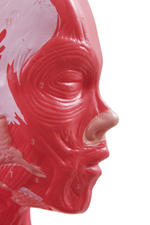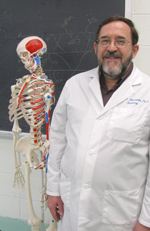|
|
|

|
Gift from the lab
Gross Anatomy takes students on learning journey to heart
|
by Dawn Brazell
Public Relations
The bodies draw the attention, all laid out on their dissecting
tables.
 We
all pretend this is a normal, every day occurrence to walk in a room
of cadavers, all donors to MUSC’s Anatomical Gift Program. They can’t
speak to tell their stories, but there’s a sense of altruism that ties
them all together. We
all pretend this is a normal, every day occurrence to walk in a room
of cadavers, all donors to MUSC’s Anatomical Gift Program. They can’t
speak to tell their stories, but there’s a sense of altruism that ties
them all together.
Laid out beneath their red protecting covers, they all seem the same
until we get to know them better.
There are the stitches on one man’s wrist. Varying amounts of body fat.
Body scars that tell a story. The pacemakers and spinal stimulators.
Some of the donors have more body hair than others, an oddly touching
sight in the brightly-lit laboratory with its hanging skeletal models
and anatomical textbooks propped up on stands for today’s lab session.
Christopher Bridges, first-year medical student, tentatively continues
his dissection of the pectoral region on the body at his team’s table.
He likes it that they have a friendly competition with another
dissecting team that comes in on another day. The teams share
information and teach each other.
They’ll be in gross anatomy lab for three to four hours today. It makes
for long afternoons for the MUSC medical students. So far, he hasn’t
dreamed about it.
“I’ve dreamed about medical school, but not gross anatomy—yet,” he
said, smiling. “And, I’m OK with that!”
 Dr. David Bernanke
in the gross anatomy lab where his easy-going manner helps students
adjust to the lab. Dr. David Bernanke
in the gross anatomy lab where his easy-going manner helps students
adjust to the lab.
David Bernanke, Ph.D., director of MUSC’s Anatomical Gift Program,
jokes with the students. Having taught this type of course since 1986,
he knows how to handle the intricate balance required in gross anatomy
that aims at desensitizing students enough to be able to study and
learn medicine, while preserving a reverent attitude necessary for
anyone in the healing professions.
The students all cope in their own ways. On some tables, the faces are
draped.
I ask one team why they chose to do so. A female medical student
quickly answers: “To preserve the body.” Another, Donald Barr, pauses
in his methodical dissection of fat and fascia to add, “There’s
probably more to it than that.”
The team’s silent a moment, processing the comment.
MUSC gets about 60 donations a year, averaging six or seven a month.
Bernanke, as director, often talks to these potential donors. He
doesn’t ask them why they’ve made the choice to give their bodies to
science, but often they volunteer that anyway.
“They say that they’re giving back and what they’re giving back is to
the body of knowledge,” he said. “They’re helping train a doctor or a
physical therapist or a dentist, and through that, they’re helping a
lot of people.”
There has been a trend to go to 3D imaging as a way to train these
students. Bernanke welcomes technological advances, but knows from
years in the lab the value of hands-on training. “You learn as a child
by reaching out and touching the world. If you pick up something in
your hand, you immediately know how big it is, how heavy it is, what it
feels like, how resilient it is. This tactile-based learning is an
important part of gross anatomy just like it is for any kind of
learning—for a child to learn or a mechanic.”
He recently was asked by a doctor interested in becoming a donor if
they still needed bodies.
“The answer is absolutely yes.”
An unusual feature about MUSC’s program is the student-led memorial
service held each year at St. Luke’s Chapel in honor of the donors to
MUSC’s program. The service gives students an opportunity to relate to
the families of these donors. It’s a time they can say thanks and make
a personal connection, he said.
“It’s an excellent thing to do, and it caps off what we want the
students to get—no matter what program they’re in—in terms of the
relationship to people, patients, the world.”
The service and the course hit home for the students.
Barr said gross anatomy has been his favorite part of medical school so
far. It gives him a chance to step out of conceptual concepts to
physically grapple with something tangible to study, he said.
“The most difficult parts to adjust to have been the
flashes of humanity that I see in the individuals who have given his or
her body for us to learn from. It usually comes out of
nowhere, but I’ll be in the middle of a dissection, and I’ll wonder
what her story is, or how something about her is slightly
familiar. It can be tough being so intimate, but remain
disconnected at the same time.”
Though he likes 3D computer models as a supplementary learning tool, it
doesn’t equal working with a real body that offers a connection a
computer screen just can’t, he said. “There is something about
touching, manipulating and being a part of the physical unfolding of
the structures that connects you to what you’re doing. It’s
knowing you’re working with a real person that you truly start to
understand what a privileged position we are in as future physicians.”
Bernanke said there are the funny moments during class, such as when a
donor’s arm will happen to drape a student. They do joke to keep it
from being too somber, but they’re careful not to cross the line, he
said. He recalls a few years back when it was time for the last exam.
The bodies were in black bags at that point on the tables. It marks a
time when students are “crazy busy” before the exam and staying late in
the lab to study. Generally, there are papers, stools and benches all
over the place.
“Well, I walked in and the place was neater than a pin. I thought maybe
I had come on the wrong day. I looked around the lab and over on one
table on the back row of the lab, there’s a bouquet of flowers on one
of the body bags, so I just left it there. Everyone was very touched by
this. When the body was removed for cremation, the flowers went as
well. It was the single most touching moment when I realized the level
that they appreciate the gift that the people give them.”
Barr said it’s impossible not to be deeply touched.
“You can’t help but revere and respect the courage of the person on the
table; more exposed and vulnerable than they ever were in life. We
have professors directing the lab activities, but they are really the
ones teaching us. It takes a kind of selflessness and caring
that I’m not sure I have myself, so I struggle with the hypocrisy of
benefiting from their sacrifice but being uncertain if I’d be able to
make the same one.
“That’s one of those moments when the humanity of their gift can be a
little overwhelming. The best way I try to show my thanks is by making
the most of every opportunity to study and learn through them.”
Want to be a donor?
The Anatomical Gift Program falls under the umbrella of the Center for
Anatomical Studies and Education (CASE). Thierry Bacro, Ph.D., and
director of CASE, said that the Center for Anatomical Studies and
Education was created in 2009 to establish an academic structure within
the newly re-named Department of Regenerative Medicine and Cell Biology
to host the activities related to teaching of anatomical sciences to
the students in the College of Dental Medicine, the College of Health
Professions and College of Medicine, as well as to provide a university
interface to support and promote anatomical research studies,
educational projects and continuing education workshops at MUSC.
For more information about the MUSC’s Anatomical Gift Program, visit
http://regmed.musc.edu/BodyDonationProgram.htm
or e-mail your request
to giftofbody@musc.edu.
Friday, Oct. 15, 2010
|
|
|



 We
all pretend this is a normal, every day occurrence to walk in a room
of cadavers, all donors to MUSC’s Anatomical Gift Program. They can’t
speak to tell their stories, but there’s a sense of altruism that ties
them all together.
We
all pretend this is a normal, every day occurrence to walk in a room
of cadavers, all donors to MUSC’s Anatomical Gift Program. They can’t
speak to tell their stories, but there’s a sense of altruism that ties
them all together.